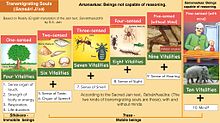Vitalism (Jainism)
| Part of a series on |
| Jain philosophy |
|---|
 |
| Concepts |
|
| People |
|
Vitalism is at the core of Jain philosophy which separates Jiva (soul or life) from Ajiva (non-soul). According to Jain cosmology, the whole universe is made up of six simple substances and is therefore eternal. These six substances (dravya) are:
Jiva or soul is distinguished from the rest five (termed Ajiva) on account of the quality of intelligence with which it is endowed and of which the other substances are devoid.
Overview
[edit]
According to Jainism, there are ten vitalities or life-principles:
- The five senses (touch, taste, smell, sight, hearing)
- Energy
- Respiration
- Life-duration
- The organ of speech
- The mind
According to major Jain text, Tattvarthsutra: "The severance of vitalities out of passion is injury". Because life is to be considered sacred and in every living thing, Jains avoid killing any living creature. They are not only vegetarian, but decline to eat vegetables that grow under the ground because each underground stem contains infinite number of vitalities each of that can potentially grow into full-fledged plants. The table below summarizes the vitalities that living beings possess in accordance with their senses:[2]
| Senses | Number of vitalities | Vitalities |
|---|---|---|
| One sense | Four | Sense organ of touch, strength of body or energy, respiration, and life-duration. |
| Two sense | Six | The sense of taste and the organ of speech in addition to the former four. |
| Three sense | Seven | The sense of smell in addition to the former six. |
| Four sense | Eight | The sense of sight in addition to the former seven. |
| Five-sensed beings |
Nine | The sense of hearing in addition to the former eight. |
| Ten | Mind in addition to the above-mentioned nine vitalities. |
See also
[edit]References
[edit]- ^ Pujyapada (Shri.) (1960). S. A. Jain (ed.). Reality. Vira Sasana Sangha. pp. 62–63.
 This article incorporates text from this source, which is in the public domain.
This article incorporates text from this source, which is in the public domain. - ^ Jain, Vijay K. (2012). Acharya Amritchandra's Purushartha Siddhyupaya. Vikalp Printers. pp. 62–63, 196. ISBN 9788190363945.
